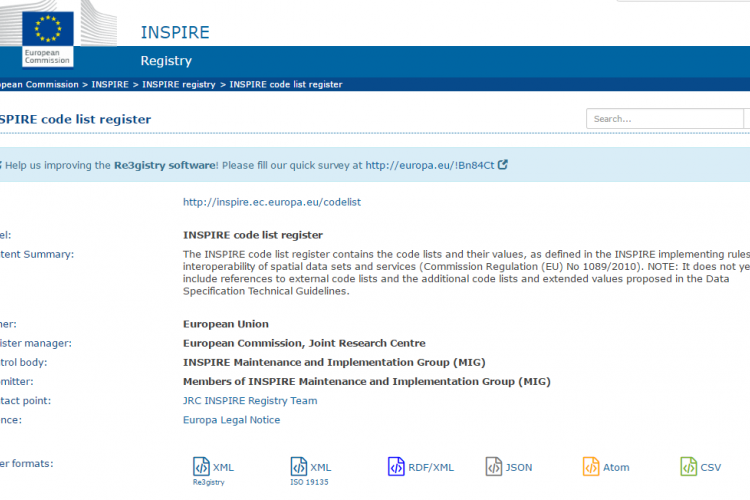How to extend INSPIRE Code lists: a practical example
Code lists are used extensively in the INSPIRE data models. They can be classified according to their governance (INSPIRE governed vs externally governed) and their extensibility:
- not extensible (none)
- extensible with narrower values (narrower)
- extensible with additional values at any level (open)
- any values allowed (any)
INSPIRE governed code lists are stored in the INSPIRE code list register, in order to allow implementers, users and applications to look up the values and their definition.
When the code list allows extension, you could add relevant new values - i.e. extend - to suit your needs.
According to the INSPIRE Implementing Rules - Article 6(3) in the COMMISSION REGULATION (EU) No 1253/2013 amending Regulation (EU) No 1089/2010 - the additional values and their definition ‘shall be made available in a register’. Nevertheless, you cannot add your new values directly to the INSPIRE code list register.
You have to create a relevant resolvable http URI for each new code list value.
The Annex C of the – still draft - ‘Technical Guidelines & Best Practices for INSPIRE registers and registries’ describes how to extend INSPIRE code lists and provides relevant examples - download the final draft.
Find below a practical example from the GeoSmartCity project, in which several code lists from BU and US data themes have been extended.
More specifically, a GeoSmartCity code list register has been implemented making use of the Re3gistry software, an open source solution developed by the European Commission’s Joint Research Centre within the ISA programme through the ARE3NA project.
By means of example, let's consider the INSPIRE Current Use code list (http://inspire.ec.europa.eu/codelist/CurrentUseValue), which has been extended with narrower (more specific) values in the extended code list (http://hub.geosmartcity.eu/registry/codelist/CurrentUseValue/)
e.g.
the http://inspire.ec.europa.eu/codelist/CurrentUseValue/office has been specialised introducing the values:
‘public office’ (http://hub.geosmartcity.eu/registry/codelist/CurrentUseValue/publicOffice/),
‘governmental office’ (http://hub.geosmartcity.eu/registry/codelist/CurrentUseValue/governmentalOffice) …
You may find it useful to have a look at the video tutorial “How to manage Code lists according to INSPIRE - An encoding example using HALE OpenSource “.
Last but not least, interesting discussions on the extension of INSPIRE code lists can be found in the INSPIRE Thematic Clusters Platform, the European Commission initiative with the objective of supporting INSPIRE implementation in the Member States.



Post comments
(No subject)
That is an ideal technology for all of us.
(No subject)
Its a great pleasure reading your post.Its full of information I am looking for and I love to post a comment that "The content of your post is awesome" Great work.
recommended you read
Good
I have read this full post which is about how extend inspire code lists. You have shared an example and explain it to us here. This is very informative for all of us and I think we all should read it once. I will must visit here again to read more.
Tarpaulin Sheet